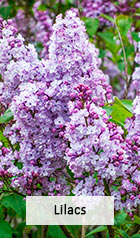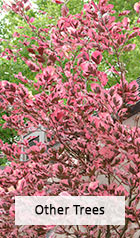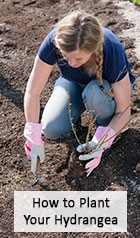- Fall Preview
- Perennials
Close X
Reliable color year after year.
- Bulbs
Close X
Fill your summer with blooms.
- Clematis & Vines
Close X
Provide ambiance and romance.
- Shrubs
Close X
Habitat, color & design possibilities.
- Trees
Close X
A gift for the next generation.
- Patio Orchard
- Fruits
- Tools & Décor
Close X
The right tools make gardening a pleasure.
- Spring Clearance
- Gardening Resources
Close X
Tips and tricks for easy, beautiful gardens.
All Clematis Plants - Flowers and Vines
Clematis Vines
Clematis plants have vines that are vigorous growers with beautiful flower blooms.

Stunning clematis plants are prized for their bright flowers of white, red, purple or blue. Clematis vines are also vigorous growers, able to quickly cover horizontal or vertical spaces with multitudes of branches and beautiful blooms. Mix varieties of these flowering plants for an array of colors, flower forms, foliage and bloom seasons. Clematis plants are not only vibrant but they also come in a wide range of heights. Some varieties grow above 20 feet tall. Shop Spring Hill Nurseries clematis for sale now and find the perfect plant for your garden today!
Not all Clematis plants are pruned the same way--see our EZ Pruning Guide and blog. Read more about Ready to Grow clematis from Newswire.
Not all Clematis plants are pruned the same way--see our EZ Pruning Guide and blog. Read more about Ready to Grow clematis from Newswire.
How to grow Clematis vines
Clematis vines are the queens of the climbing plant world! If you have a healthy clematis plant, the question is less "how to grow clematis vines" and more "how to train clematis vines." However, these happy and vigorous growers are perfectly content being trained or shaped to suit your garden, and they'll reward a little work in establishment with years of beautiful blooms.
Choose a sunny spot for your clematis vine. When planting it's a good idea to remove some of the soil and mix it with some compost-amended soil before backfilling over the roots of your clematis. Although clematis don't like to be overly wet, make sure you keep the soil moist during their first growing season: then water on a regular schedule afterwards. Using a balanced fertilizer on your clematis, such as a 10-30-20, several times during the season will meet the growing needs of your clematis.
Clematis need something to climb on, or they will cease flowering. So, you'll need to place a thinly-hewn trellis or climbing netting near your clematis. Clematis twine around their supports with leaf tendrils, but clematis vines are not thick and woody, such as a wisteria vine would be.
Clematis are perennials, meaning that, with a little care, they'll come back year after year. As part of that care, your clematis may require some pruning! However, not all clematis should be pruned the same way. Some clematis varieties only flower best on "old wood," meaning that their branches need to stay intact over winter and into the next spring. If you have a clematis variety that blooms best on old wood, it's best to avoid pruning. However, if you must prune, do so only after flowering and only to remove damaged growth or keep it tidy.
Other clematis flower on old or new vines: when pruning these varieties, use caution to retain healthy stems from last season for best flowering.
Finally, there are clematis varieties that flower on new vines that emerge from the ground each year or from stems near the bottom of older vines. Prune these clematis hard in the spring and as often as you like during the season to encourage reblooming and keep the plants tidy.
Spring-and summer-blooming clematis benefit from deadheading, so remove faded flowers from these plants to encourage reblooming. These clematis vines tend to be the variety that bloom on old wood, but also rebloom on new growth, so removing faded blooms can encourage a second round of flowers.
How to plant Clematis plants
Clematis aren't particularly picky plants, they usually adapt well, but there are a few things to take into consideration when selecting an optimized growing environment. First choose a location with well-drained soil, or be prepared to amend the soil to create a well-drained spot. Clematis vines like the sun but do not have to have full sun. Most clematis perform well in a location anywhere from full sun to partial shade - and contrary to myth, they do not 'need' to keep their feet in the shade. A thick layer of mulch around the base of your clematis will help to keep its roots cool.
Your clematis will need something to climb on, such as a trellis, so "plant" that structure at the same time you plant the clematis. Clematis plants wrap their leaves around structures to climb -- they don't twine like morning glories -- so make sure that your climbing structure is "grabbable" for your plant. Use a trellis with thin (under one half-inch) rods, or try netting made of twine or line.
Once you've chosen a location for your clematis vines, unwrap or unpot your clematis, and soak the roots of the plants in a bucket of water for about fifteen minutes. Be sure that the hole you dig for your clematis is large enough to spread its roots out and as you plant your clematis be sure the bottom-most nodes of the plant go into the soil.
Before you refill the hole containing your newly-planted clematis, consider amending the soil you've removed with a good organic compost to help your clematis quickly grow into the new soil.
The climbing structure should be placed at the same time you plant the clematis. By having a trellis, arch, or climbing net in place, your clematis vines can immediately start twining around their new supports -- and, you'll avoid injuring the roots of the plant by staking the supports into the ground after the roots have begun to grow. Water in well, and water your clematis vines a few times a week. Once they've settled in and new growth begins, clematis will benefit from a 10-30-20 fertilizer.
When to plant Clematis vines:
Most clematis can be planted in the spring, after the threat of frost has passed, but some varieties are better planted in the fall. Spring planting gives a clematis time to establish itself and enjoy a season of growth before the fall sets in. If you find that you need to transplant or relocate your clematis plants, that can also be accomplished in the spring, just before the plants begin to grow.
How fast do Clematis grow?
In most hardiness zones, many clematis varieties grow quickly. Depending on which clematis you choose to plant, after the first season or two it may grow anywhere from a few feet to its full height in one growing period. Keep in mind that until fully established (a year or two) your clematis will likely only grow a portion of its full height and produce a small amount of flowers. However, once its settled into its new location your clematis will provide you with years of joy and beauty.
If you find that your clematis eventually overtakes its support and begins creeping into areas where you don't want it, you can definitely prune it to maintain a desired size or shape. Some clematis varieties can be cut all the way to the ground every spring, while other clematis bloom on old vines and need carefully planned pruning. A good rule of thumb is to wait until spring to prune. You can remove deadwood or too long vines most anytime but for those clematis that bloom on old vines waiting until they begin to sprout in the spring allows you to know just what is deadwood and can be removed.

































